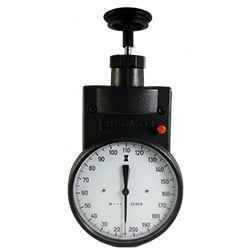Comprehensive Overview to Recognizing and Utilizing a Tachometer Efficiently
Comprehensive Overview to Recognizing and Utilizing a Tachometer Efficiently
Blog Article
The Importance of a Tachometer in Monitoring Engine Speed and Efficiency in Automotive Applications
In the world of automotive design, the tachometer stands as a crucial instrument in the driver's toolbox, offering a straight window into the internal workings of a car's engine. Past its feature as a mere gauge of changes per minute (RPM), the tachometer works as a vital device for enthusiasts and experts alike, providing real-time understandings into engine performance and wellness. Understanding the significance of this gadget goes past surface-level monitorings, delving right into the complex partnership in between engine speed, power outcome, and general driving experience. As we check out the diverse function of the tachometer in automotive applications, a much deeper gratitude for its influence on car dynamics and performance starts to arise.
Importance of Keeping Track Of Engine RPM
Monitoring engine RPM, or revolutions per minute, is a vital element of auto maintenance and efficiency examination. Engine RPM straight correlates with the speed at which the engine's crankshaft turns, showing just how swiftly the engine is running.
Furthermore, keeping an eye on engine RPM is essential for efficiency analysis in racing and high-performance cars. Keeping optimum RPM levels is vital for achieving peak power outcome and velocity. Racers commonly use tachometers to ensure they are running within the optimal RPM variety for optimum efficiency. In summary, monitoring engine RPM is not only vital for identifying issues but likewise for optimizing engine performance in various auto applications.

Advantages of Real-Time Information
In automobile applications, real-time information plays a critical function in offering instant insights right into the efficiency and problem of the vehicle. By continuously checking various parameters such as engine rate, temperature, fuel intake, and more, real-time data supplies many advantages that add to improved efficiency and safety on the roadway.
Furthermore, real-time information facilitates efficiency optimization by offering immediate responses on driving practices and engine efficiency. Motorists can adjust their behavior in real-time based on this details to attain much better gas economic climate and lengthen the lifespan of their vehicle.

Additionally, real-time data plays a vital duty in contemporary automotive diagnostics, allowing technicians to promptly identify and deal with breakdowns. This results in minimized downtime, lower maintenance costs, and inevitably, enhanced general vehicle reliability and long life (tachometer). By harnessing the power of real-time information, automotive stakeholders can make educated choices that favorably impact both the efficiency and durability of the vehicle
Effect On Gear Shifts
The tachometer plays an essential function in optimizing gear changes by giving real-time engine rate data to the vehicle driver. When approaching the redline on the tachometer, it signals the chauffeur to upshift to stop over-revving the engine and triggering possible damage.
Furthermore, the tachometer help in accomplishing smoother gear changes, particularly in hand-operated transmissions. By monitoring pop over to these guys engine speed, vehicle drivers can implement gear changes at the optimal RPM range, decreasing snagging motions and reducing endure the transmission components. This accuracy in gear modifications not only enhances driving convenience yet additionally adds to sustain effectiveness.
Enhancing Fuel Performance
Offered the vital function the tachometer plays in maximizing gear shifts for performance and engine wellness, it directly adds to making best use of gas efficiency in automotive applications. By supplying real-time responses on engine speed, the tachometer aids chauffeurs in keeping the most efficient RPM array for gas economy. When drivers regularly keep track of the tachometer and readjust their driving practices appropriately, they can avoid unneeded fuel usage brought on by over-revving or carrying the engine.
In addition, the tachometer aids chauffeurs identify the most fuel-efficient equipment to be in at i loved this any kind of given minute, protecting against the engine from working more challenging than needed. This is specifically critical throughout acceleration and travelling, where being in the right equipment can dramatically impact gas efficiency. Additionally, the tachometer can alert drivers to prospective mechanical problems that can be adversely influencing fuel economic climate, such as a sliding clutch or a clogged up air filter. In verdict, the tachometer functions as a useful tool in enhancing gas efficiency by advertising ideal driving practices and identifying areas for renovation in the vehicle's efficiency.

Maximizing Engine Long Life
The tachometer's function in checking engine speed and efficiency contributes in ensuring the longevity of automotive engines. By making use of the tachometer effectively, motorists can enhance engine durability via mindful RPM management. Constantly revving an engine expensive can cause excessive damage on important elements, such as the pistons, valves, and bearings. With time, this can cause decreased engine efficiency and potential breakdowns. Checking the tachometer permits chauffeurs to remain within the recommended RPM array for their car, stopping unneeded strain on the engine and prolonging its life expectancy.

Conclusion
In verdict, the tachometer plays an important role in keeping track of engine rate and efficiency in vehicle applications. By giving real-time data on RPM, it permits effective gear shifts, boosted gas effectiveness, and optimized engine longevity. This tool is important for maintaining optimal engine performance and making certain the general capability of a car.
Report this page